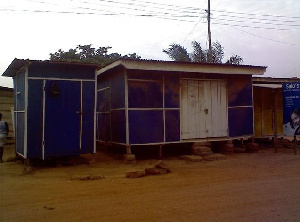Regional News of Wednesday, 6 October 2021
Source: happyghana.com
Kiosk housing is feasible – GREDA boss supports call
The Executive Secretary of the Ghana Real Estate Developers Association (GREDA), Samuel Amegayibor, has called on the government to pay attention to suggestions made by stakeholders in the housing sector on how to reduce the housing deficit.
He made this statement in connection to the suggestion made by the Director of Lakeside Estate, Salah Kwaku Kalmoni during the recent Happy Development Dialogue Series hosted by Happy 98.9FM.
The innovative businessman believes the introduction of proper kiosk settlement will go a long way to reduce the incidence of people sleeping on the streets, and being unable to afford safe and hygienic accommodation.
While some have not welcomed this suggestion, Samuel has said that it is one of the best suggestions to deal with the housing deficit in the country.
Thus, in an interview with Samuel Eshun on the Happy Morning Show, he encouraged the government: “The most important thing now is to interrogate the suggestion made by Mr. Kalmoni. We have to subject it to technical interrogation, see the cost involved and check what we can do to improve it. It could be that the current standards of how people are building is not right so we as professionals can help in such an area.
These are very laudable ideas. You might not put your mind to it but if you coordinate it and make it formal, you will realize that people will leave in healthy conditions.”
He added that in some developed countries such as the USA or the UK, alternative housing has been embraced such that people live structures such as vehicles with bathrooms, bedrooms, and other amenities that make life comfortable.
“As a country, we are not into social housing but if the government can bring in some of these suggestions, we, the professionals are here to help”, he said.
A preliminary report from the Ghana Statistical Service on the 2021 Population and Housing Census (PHC) has revealed that about 2.1 million structures are metal containers, kiosks, and structures.
This number represents twenty percent of the 10.7 million structures listed in the Population and Housing Census.
According to the report, “The 2021 PHC is the first time that data was collected on all structures regardless of use. Previous censuses only collected information on structures used for residential purposes. The 2010 PHC recorded 3.4 structures for residential use, which is 2.5 million less the 5.9 counted in 2021”.
Entertainment










